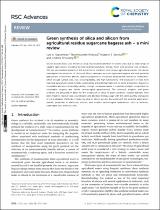Green synthesis of silica and silicon from agricultural residue sugarcane bagasse ash – A mini review
| dc.contributor.author | September, Lyle A. | |
| dc.contributor.author | Kheswa, Ntombizonke | |
| dc.contributor.author | Seroka, Ntalane S. | |
| dc.date.accessioned | 2023-01-27T07:13:01Z | |
| dc.date.available | 2023-01-27T07:13:01Z | |
| dc.date.issued | 2023 | |
| dc.identifier.citation | September, L. A. et al. (2023). Green synthesis of silica and silicon from agricultural residue sugarcane bagasse ash – A mini review. RSC Advances, 13(2), 1370-1380. 10.1039/d2ra07490g | en_US |
| dc.identifier.issn | 2046-2069 | |
| dc.identifier.uri | 10.1039/d2ra07490g | |
| dc.identifier.uri | http://hdl.handle.net/10566/8310 | |
| dc.description.abstract | Silicon dioxide (SiO2), also known as silica, has received attention in recent years due to wide range of capable applications including biomedical/pharmaceutical, energy, food, and personal care products. This has accelerated research in the extraction of materials from various agricultural wastes; this review investigates the extraction of silica and silicon nanoparticles from sugarcane bagasse ash with potential applications in electronic devices. Specific properties of silica have attracted the interest of researchers, which include surface area, size, biocompatibility, and high functionality. The production of silica from industrial agricultural waste exhibits sustainability and potential reduction in waste production. Bagasse is sustainable and environmentally friendly; though considered waste, it could be a helpful component for sustainable progress and further technological advancement. | en_US |
| dc.language.iso | en | en_US |
| dc.publisher | Royal Society of Chemistry | en_US |
| dc.subject | Agriculture | en_US |
| dc.subject | Silicon oxides | en_US |
| dc.subject | Green synthesis | en_US |
| dc.subject | Silica nanoparticles | en_US |
| dc.subject | Chemistry | en_US |
| dc.title | Green synthesis of silica and silicon from agricultural residue sugarcane bagasse ash – A mini review | en_US |
| dc.type | Article | en_US |

